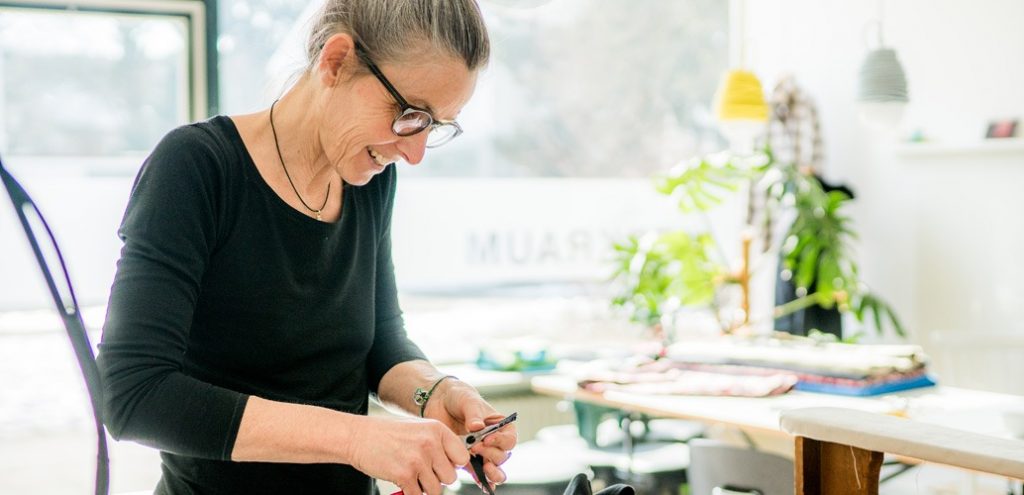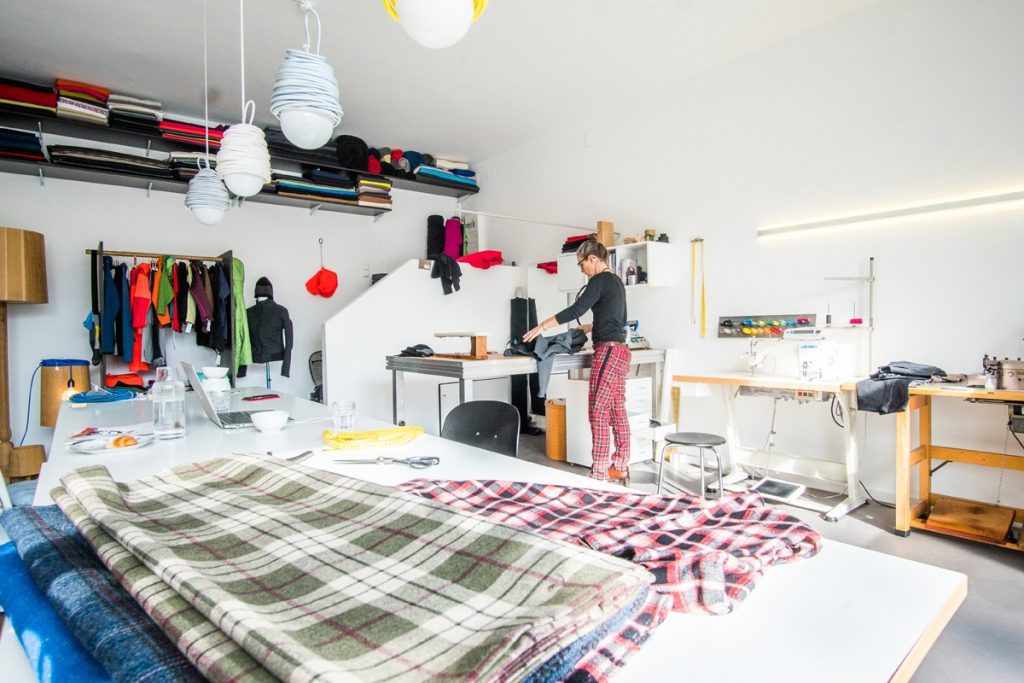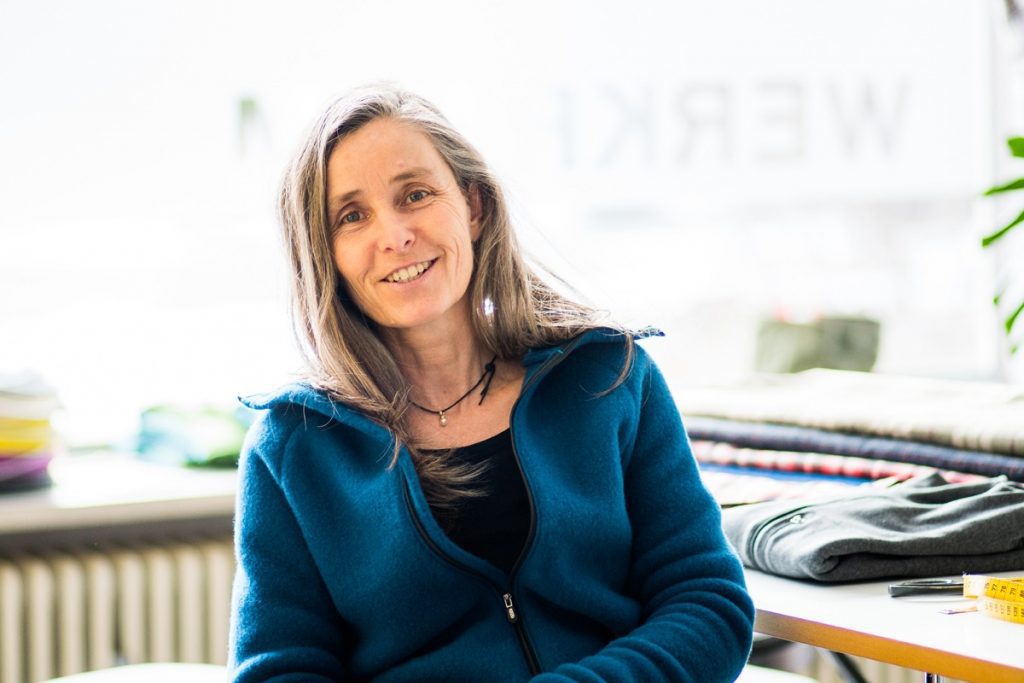“People are looking for more sustainable products“
- minutes reading time
Buy less, choose well, make it last - what Vivienne Westwood preaches is put into practice by master tailor Barbara Heinze in her Munich studio. Sympatex has been cooperating with the Munich-based designer for several years now, who provides a repair service for ecological outdoor clothing.

Barbara, when and how did you start your own studio?
I did an apprenticeship as a tailor and ended up directly in the outdoor industry, where I was responsible for design and product development. After that I studied fashion graphics for three years and at the same time I made my master tailor. During this time, while I was mainly working freelance for various outdoor brands in design, I realized that the outdoor industry mainly works with very environmentally harmful materials. But since I couldn’t change anything about this problem with these large corporations, I returned to the tailoring trade and without further hesitation founded my own outdoor children’s line in 2008, which is as ecological as possible – thanks to the use of exclusively bluesign-certified fabrics or recyclable, PFC-free Sympatex laminates.
I also work without the usual fast-changing collections, because on the one hand I cannot afford this as a one-woman business and on the other hand I am interested in creating sustainable designs that are still wearable after 10 years. Besides that I worked for Patagonia for a long time and supported the “Worn-Wear-Project” with my technical know-how. In order to include jackets that are no longer repairable in the collection cycle, I also started collecting them in my studio and processing them into new products.
What is the biggest problem with (outdoor) clothing?
Over the years, technical development has brought us super qualities and materials, e.g. the great innovation of water resistance – today this is taken for granted. Jackets are also becoming lighter and lighter and rustle less. However, innovations often come at the expense of our environment, as more and more chemicals are used for this purpose, which are very harmful to our environment. And for the consumer, it is impossible to see through what kind of material was used and how it was created. Even I sometimes think it would be helpful to have studied chemistry in order to better understand the manufacturing processes. Many people don’t even know how to wash their clothes properly because they have no idea what material they are actually wearing and thus delaminate their clothes in a very short time. Even as a buyer, it is difficult to select unstressed materials and fabrics. Therefore, sustainable companies are now very keen to employ their own environmental officers to deal with these problems.
“Which materials and fabrics do you use for your designs and why?
I want to work without PFC equipment and chemicals. However, I have also unintentionally bought material that contained fluorocarbon C8 chemistry (=perfluorooctanoic acid / PFOA) – without knowing it, because I was given false information about the production of the material. Therefore, I always try to make sure that the material has been produced without any harmful substances before I buy it. The bluesign label assures certain minimum standards in the synthetic fibre sector, but does not guarantee that the material is 100% free of harmful chemicals.
In the merino jersey area I only use wool from KbT, a quality seal I can rely on. Of the natural fibres, hemp is the most ecological what you can buy, as there are mostly completely certified products. In the cotton sector I only buy GOTS (Global Organic Textile Standard) – or iVN products.

Where do the materials come from and how can you be sure that what you use is 100% sustainable?
It is easier in the natural fibre sector, as here the quality seals are relatively secured with certificates that are assigned to a fabric. Unfortunately, my trust in bluesign has already been disappointed in the synthetic fibre sector. But it has developed a lot, for example thanks to the Greenpeace detox campaign. The outdoor industry is basically already open-minded here, but of course the price always plays a big role. And it is of obviously much more difficult for large companies to change than for small businesses. I only buy what I need and I don’t have a large production in the background, so it’s easier for me to change things quickly. For large companies it is more difficult to test the material over and over again and they have to spend a lot of money on product development. This gives me a big advantage and I can live and implement “slow fashion” more easily.
Sustainability is also a question of pricing. Do you think the consumer trend is more towards paying more attention to price, more to design or more to sustainability?
I’m not a businesswoman and don’t have a great overview of the market, but from my own experience I can say that it’s a tough battle in direct sales, without intermediate trade. I am often well above the average price and I keep my children’s line “Let Life Flow” more out of enthusiasm – the turnover comes primarily from my adult line. The group of people who are willing to spend more money on an organic product is still very small in my opinion.
“What can I do if I have little money but would like to use sustainable textiles?
The Second-Hand market is certainly a good way – I think it is a big advantage that you can buy many things used. It is also important to point out that the wardrobes are overfilled to 90% anyway. It is therefore always better to buy a sweater that is perhaps a little more expensive, but more sustainable and of higher quality and therefore much longer in use than five sweaters, which are virtually garbage from the start. Or as environmentalist and creative icon Vivienne Westwood once put it: “Buy less, choose well, make it last – because we don’t need so much.
More and more people live on this planet and the population will continue to grow. The struggle for raw materials has long begun. Will consumer behaviour (have to) change fundamentally?
Yes, absolutely! Here I am also grateful to Patagonia for advertising in this direction. “Don’t buy this jacket” was the first big marketing campaign here and now also the “Worn Wear Campaign”. In this way, the consumer can be made aware of the topic “reducing consumption”. This is totally anti-capitalistic, but actually high time – but of course most companies don’t support it because of this. The main credo for companies is still profit maximisation. However, the question remains open as to whether the market itself regulates the “problem” of consumer behaviour or whether it needs to be controlled from outside. I’ve done a lot of research on post-capitalism and economists like Niko Paech – but I don’t know if that works in reality – although I personally find the approaches ingenious.

You offer a Repair & Upcycling Service, do the customers appreciate this service?
This service is used extremely often. I am in an absolute niche position here, as there are currently not many possibilities for a good quality repair of outdoor wear. Unfortunately, the tailoring trade is dying out – I have often thought about quitting. Even in fairy tales there is often talk of the “poor little tailor” – and in everyday life this was bitter reality. Unfortunately, the tailoring trade has always been poorly paid and only the tailors in the city with a wealthy clientele made a good living. And industrialisation has further decimated the value of clothing.
But through the repair the tailoring trade becomes respectable again and therefore master tailors who know their trade are in demand again. The trend around creative DIYs, upcycling and repair cafés leads to an increased demand. Meanwhile, many people are once again placing more value on sustainable products. But of course we are talking about an upper class – the majority of the population has not yet embraced this trend.
In the meantime, there are so many seals and certificates that they tend to unsettle consumers rather than provide orientation. Where is the best place to get information about fair & sustainable fashion?
Consumers should be very attentive in any case. Many hangtags are only marketing and advertise the company’s own labels. The company VAUDE, for example, has created the Green Shape label. At the moment I trust this label the most of all outdoor brands. The consumer should not be deceived by supposedly ecological labels, as many people here do extreme greenwashing. The best thing to do is to find out before buying online. One should try to look behind the scenes and check whether the label is a company label or not. Greenpeace’s environmentally friendly and fair shopping guide also offers a good overview here. However, consumers must be aware of this issue. A new, higher-level label is currently being created here with the state label Grüner Knopf. However, the guidelines have already been watered down considerably here, as they were probably too strict at the beginning.
“How do you personally live sustainability and do you have a very special tip on sustainability and fashion in everyday life that everyone should know?
Attention and mindfulness are very important. And what you can implement, you should implement. I haven’t had a car for a year and I use CarSharing offers and the bicycle, I only buy – if at all – ecological and fairly produced clothes and organically grown food. Clothing is a basic human need, but you have to start to rethink, shop more carefully and don’t just buy a T-shirt as a reward. The topic of plastics is also a big problem – here too, mindfulness is particularly important.

コメント (0)
Write the first comment